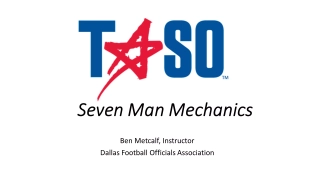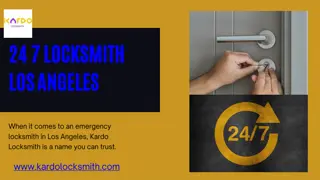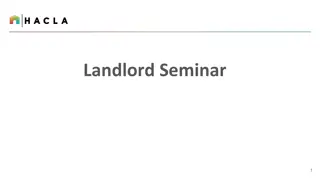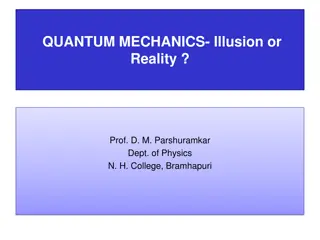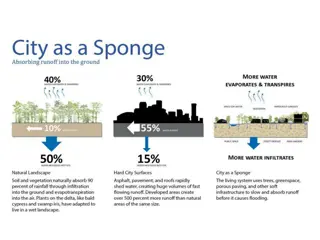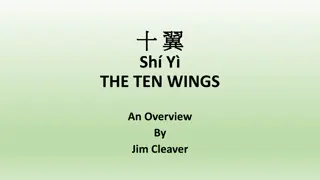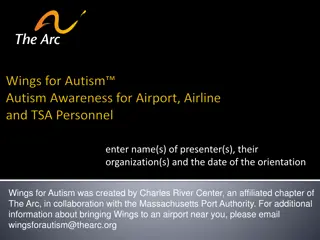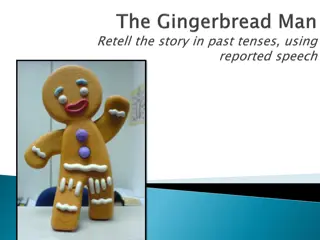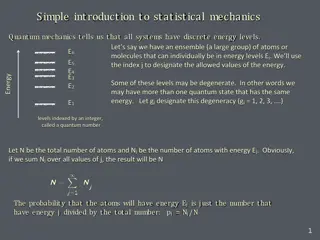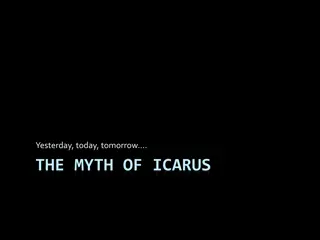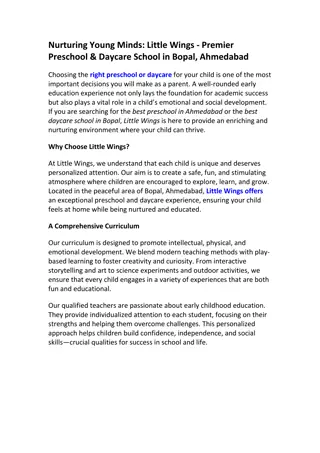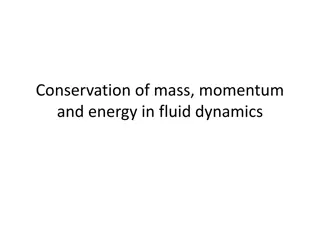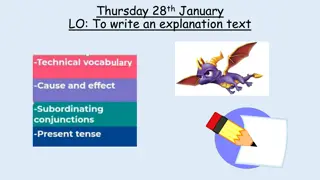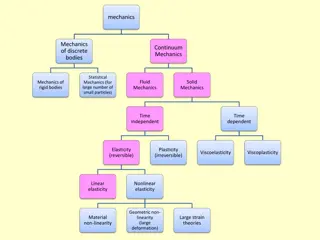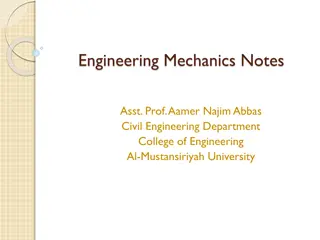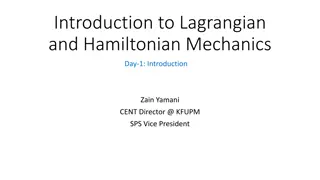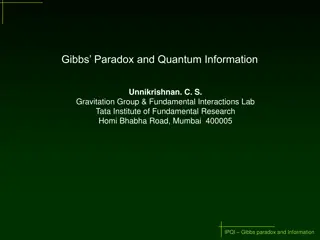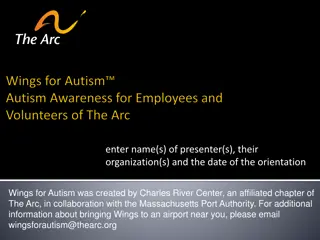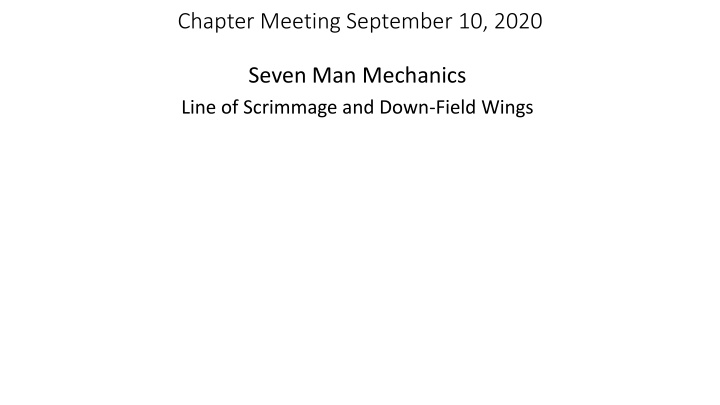
Seven-Man Mechanics for Football Officials: Line of Scrimmage and Down-Field Wings
Explore detailed instructions for football officials on utilizing seven-man mechanics effectively during games. Learn about specific roles and responsibilities for Head Linesman, Line Judge, and Side Judge/Field Judge, including positioning, reading plays, and marking forward progress.
Download Presentation

Please find below an Image/Link to download the presentation.
The content on the website is provided AS IS for your information and personal use only. It may not be sold, licensed, or shared on other websites without obtaining consent from the author. If you encounter any issues during the download, it is possible that the publisher has removed the file from their server.
You are allowed to download the files provided on this website for personal or commercial use, subject to the condition that they are used lawfully. All files are the property of their respective owners.
The content on the website is provided AS IS for your information and personal use only. It may not be sold, licensed, or shared on other websites without obtaining consent from the author.
E N D
Presentation Transcript
Chapter Meeting September 10, 2020 Seven Man Mechanics Line of Scrimmage and Down-Field Wings
Seven Man Mechanics Line of Scrimmage and Down-Field Wings Head Linesman and Line Judge: At snap read tackles to determine run or pass. When run is read; maintain position on LOS. Observe action by tackles and keys. Do not leave line of scrimmage until runner crosses it. If play coming toward you observe blocks in advance of runner. If play goes to other side, observe action behind R and U while moving downfield with play. When getting out of bounds spot, mark spot and turn facing the action. Keep head up. Let R or downfield wing retrieve ball. H and LJ should use cross-field mechanics when spotting ball. When play is over accordion in observing dead ball action.
Seven Man Mechanics Line of Scrimmage and Down-Field Wings Head Linesman: At snap read tackles to determine run or pass. When pass is read key your eligible receiver. Be prepared to slide downfield up to 5 yards, while observing action on your key in belt area (up to 10 yards downfield). Responsible for shorter passes thrown in your area. If pass is deep downfield, move downfield with pass. If pass is not thrown in your area, observe off-ball action. When runner is down, mark forward progress to the 2 yard line. H and LJ should use cross-field mechanics when spotting ball. When play is over accordion in observing dead ball action.
Seven Man Mechanics Line of Scrimmage and Down-Field Wings Line Judge: At snap read tackles to determine run or pass. When pass is read, observe blocks by tackle and action on key receiver. Stay on LOS. You are responsible for action involving LOS. Responsible for shorter passes thrown in your area. If pass is released deep downfield, move downfield with pass. If pass is not thrown in your area, observe off- ball action. When runner is down, mark forward progress to the 2 yard line. LJ and H should use Crossfield mechanics when spotting the ball. When play is over accordion in observing dead ball action.
Seven Man Mechanics Line of Scrimmage and Down-Field Wings Side Judge/Field Judge: Initial position 20 yards downfield from the LOS. On side line at 45 degree angle to sideline. At snap, step backwards one to two steps while reading run or pass. When run is observed, focus on action on and by your key. Maintain cushion in advance of play. If run is to your side observe action on lead blockers. Mark forward progress from 2 yard line to goal line. Be at goal line before runner crosses it. When play goes away from you, observe action behind U. If play goes OOB on your side, proceed into Team Area to retrieve ball and help with cleaning up play. When play is over, accordion in while observing dead ball action.
Seven Man Mechanics Line of Scrimmage and Down-Field Wings Side Judge/Field Judge: Initial position 20 yards downfield from the LOS. On side line at 45 degree angle to sideline. At snap, step backwards one to two steps while reading run or pass. When pass is read key on contact on your and by your eligible receiver and defenders. Back peddle to maintain cushion and assure maximum field of vision. Be prepared to cover sideline to end line. When ball thrown into your area watch defenders action on receivers. Mark forward progress from 2 yard line to goal line. When play goes away from you, observe action behind U. If play goes OOB on your side, proceed into Team area to retrieve ball and help with cleaning up play. When play is over, accordion in while observing dead ball action.
Catch/ No-Catch Catch/Possession: 2-4-1 which is in flight, and first contacting the ground inbounds while maintaining possession of the ball or having the forward progress of the player in possession stopped while the opponent is carrying the player in possession and in bounds. A catch is the act of establishing player possession of a live ball
Catch/ No-Catch Catch/Possession: 2-4-1 which is in flight, and first contacting the ground inbounds while maintaining possession of the ball or having the forward progress of the player in possession stopped while the opponent is carrying the player in possession and in bounds. 2-34-1 A ball in player possession is a live ball held or controlled by a player after it has been handed or snapped to him, or after he has caught or recovered it. A catch is the act of establishing player possession of a live ball
Catch/ No-Catch Catch/Possession: 2-4-1 which is in flight, and first contacting the ground inbounds while maintaining possession of the ball or having the forward progress of the player in possession stopped while the opponent is carrying the player in possession and in bounds. 2-34-1 A ball in player possession is a live ball held or controlled by a player after it has been handed or snapped to him, or after he has caught or recovered it. CATCHES/INTERCEPTIONS: On catches/interceptions if the receiver is going to the ground while in the process of making a catch and his first contact is with the ground, he must maintain control of the ball after hitting the ground. An immediate drop of the ball should be ruled incomplete. We do not want to give any cheap turnovers. When in doubt, wipe it out. (Paul Sheehan, State Rules Interpreter-PIAA). A catch is the act of establishing player possession of a live ball
Catch/ No-Catch Catch/Possession (NFHS Training Video): A catch is the act of establishing player possession of a live ball in flight, and first contacting the ground while still inbounds and maintaining possession of that ball or when the forward progress of the player in possession is stopped, while the opponent is carrying the player in possession out in bounds. The receiver must touch the ground while he is in control of the ball. If the ball is lost after he has touched the ground, due to contact or not, it should be ruled an incomplete pass instead of a fumble unless the receiver has clearly demonstrated complete control of the ball. Complete control is indicated by taking a step, tucking the ball away, or some other action ordinarily associated with running the ball.

